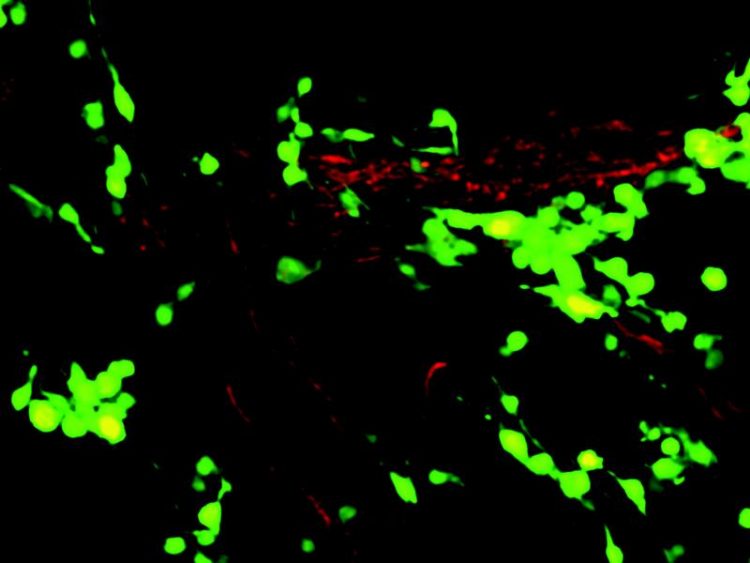Sunburns strike twice

Melanoma cells (green) migrate particularly effectively on blood vessel surfaces (red). (c) Photo: Tobias Bald/UKB
UV radiation is considered to be the most significant triggering factor. An interdisciplinary team of researchers from the University Hospital and the LIMES Institute of the University of Bonn has now discovered that sunburns contribute to the development of this malignant disease not only through direct alteration of pigment cell genomes but also indirectly through inflammatory processes in the surrounding tissue. The results are now being published online in the renowned journal “Nature”.
According to predictions from the Robert Koch Institute, approximately 20,000 people in Germany will develop malignant melanoma in 2014. More than 2500 of those affected will die from metastases to internal organs. “The inflammatory reaction of the skin after severe sun exposure promotes the early migration of melanoma cells along vessels within the body,” says Prof. Dr. Thomas Tüting, professor of Experimental Dermatology at the University of Bonn Hospital and leader of the study team.
To understand the development and early metastasis of malignant melanoma, the researchers developed experimental models in mice which allowed them to investigate the effect of inflammatory responses following UV exposure. “We repeatedly observed increased melanoma metastases in the lungs of UV-irradiated mice,” reports the dermatologist Dr. Evelyn Gaffal. Analyses of melanoma tissue sections revealed the spread of tumor cells along blood vessel surfaces in inflamed skin. Using modern methods of fluorescence and electron microscopy, the researchers observed a close association between melanoma cells, inner blood vessel walls and immune cells, especially neutrophils.
Further experiments showed that neutrophils play an important role in metastasis. They are attracted by alarm signals emitted by UV-damaged keratinocytes in the epidermis. The use of special mouse strains which lack important molecules required for the activation of innate immune defense shed light on the underlying signaling pathways.
Researchers in the LIMES Institute of the University of Bonn developed new experimental methods to investigate the interaction between melanoma cells and cells of the inner blood vessel walls, known as endothelial cells. In doing so, they observed that melanoma cells can migrate particularly effectively on blood vessel surfaces. “Melanoma cells increase their motility in an inflammatory environment,” says Prof. Dr. Waldemar Kolanus.
Further investigations with human melanoma cells and modern genomic methods provided insights how inflammatory mediators stimulate melanoma cells migration. “During embryonic development pigment cell precursors travel long distances along blood vessels in the body in order to reach their final destination in the skin. These migratory programs are erroneously reactivated in melanoma cells by inflammation,” says Prof. Dr. Michael Hölzel from the Institute of Clinical Chemistry and Clinical Pharmacology in Bonn.
“Our findings may explain why patients with superficially ulcerated melanomas and neutrophil infiltration frequently develop organ metastases” says Prof. Tüting. The researchers hope to develop new forms of targeted therapy in the future which specifically interfere with inflammatory signaling cascades and inhibit the migration of melanoma cells on the surfaces of blood vessels. The interdisciplinary cooperation between different research groups in Bonn within the Collaborative Research Center 704 and the Excellence Cluster ImmunoSensation provide an excellent basis for such ambitious projects.
Publication: Ultraviolet-radiation-induced inflammation promotes angiotropism and metastasis in melanoma, Nature, DOI: 10.1038/nature13111
Contact information for journalists:
Prof. Dr. Thomas Tüting
Senior Physician at the Department of Dermatology and Allergology and Director of the Experimental Dermatology Laboratory
University of Bonn Hospital
Tel. ++49-228-287-15370
E-Mail: Thomas.Tueting@ukb.uni-bonn.de
Dr. Evelyn Gaffal
Resident at the Department of Dermatology and Allergology
University of Bonn Hospital
Tel. ++49-228-287-16701
E-Mail: Evelyn.Gaffal@ukb.uni-bonn.de
Prof. Dr. Michael Hölzel
Institute of Clinical Chemistry and Clinical Pharmacology
Laboratory for RNA Biology
University of Bonn Hospital
Tel. ++49-228-287-12170
E-Mail: Michael.Hoelzel@ukb.uni-bonn.de
Prof. Dr. Waldemar Kolanus
Molecular Immunology and Cell Biology
Life and Medical Sciences (LIMES) Institut
Tel. ++49-228-73-62790
E-Mail: wkolanus@uni-bonn.de
Media Contact
More Information:
http://www.uni-bonn.deAll latest news from the category: Health and Medicine
This subject area encompasses research and studies in the field of human medicine.
Among the wide-ranging list of topics covered here are anesthesiology, anatomy, surgery, human genetics, hygiene and environmental medicine, internal medicine, neurology, pharmacology, physiology, urology and dental medicine.
Newest articles

Silicon Carbide Innovation Alliance to drive industrial-scale semiconductor work
Known for its ability to withstand extreme environments and high voltages, silicon carbide (SiC) is a semiconducting material made up of silicon and carbon atoms arranged into crystals that is…

New SPECT/CT technique shows impressive biomarker identification
…offers increased access for prostate cancer patients. A novel SPECT/CT acquisition method can accurately detect radiopharmaceutical biodistribution in a convenient manner for prostate cancer patients, opening the door for more…

How 3D printers can give robots a soft touch
Soft skin coverings and touch sensors have emerged as a promising feature for robots that are both safer and more intuitive for human interaction, but they are expensive and difficult…





















